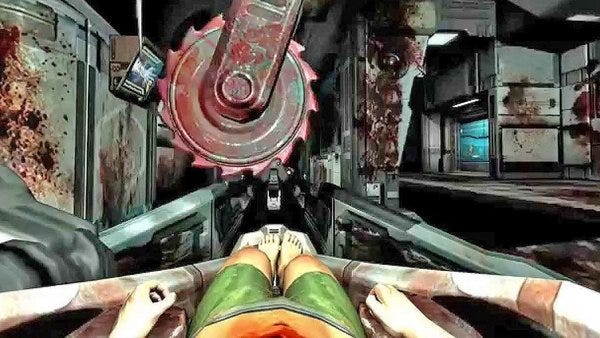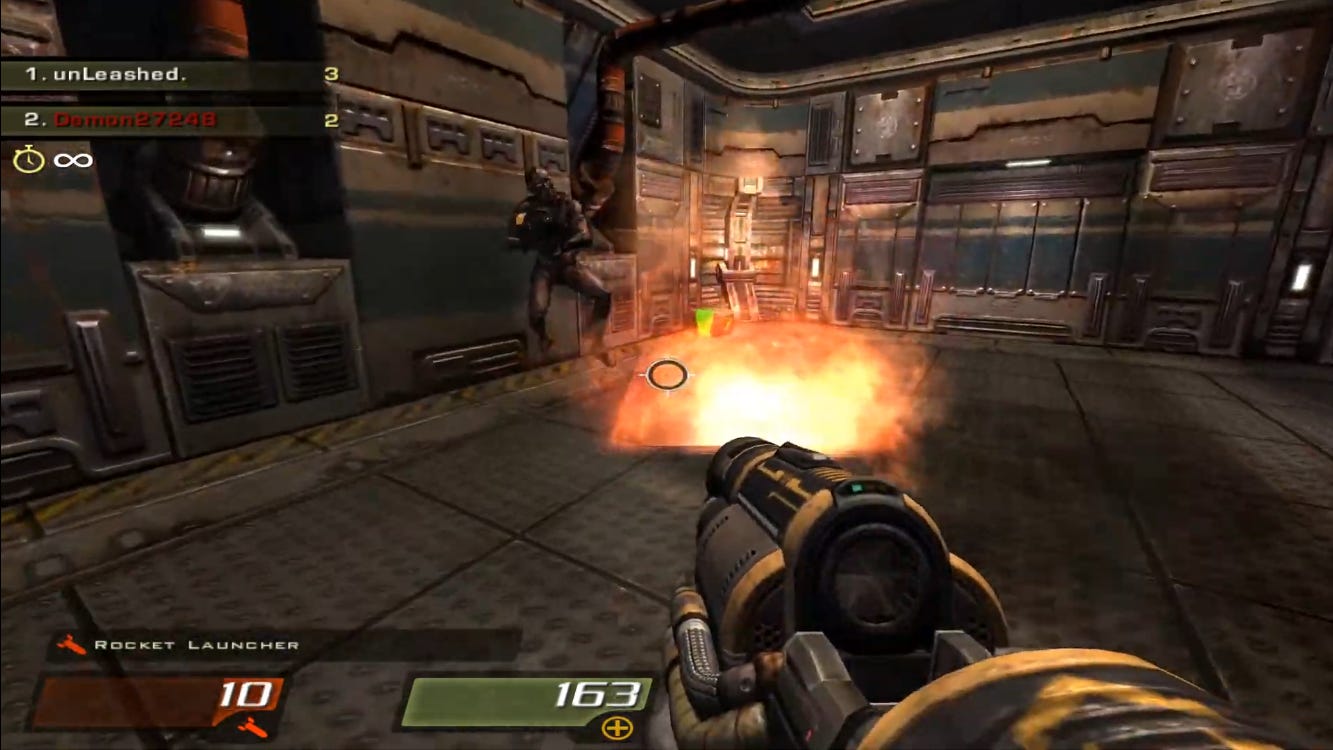Welcome to Episode Five of “Quake’s Bizarre, Beautiful History!” Read the previous episodes here:
Episode Four
Expansion Pack Two
By the time 2005 was rolling around, Quake III: Arena had been resting on its laurels while id worked on a Doom revival. Quake might have gotten a bit too comfortable, though, as Doom 3 failed to impress and many competitors like Halo and Half-Life were starting to edge it out of its niche (more on that in “Expansion Pack Two”). To really thrive in the modern shooter market, Quake 4 needed to bring its A-game. If it was going to be like the slower, more story-driven shooters of today, it needed to learn the right lessons with well-considered worldbuilding, characters, and weapons. If it was going to be like Quake games of yore, it needed to be as refined as Quake III while still upping the ante. It wasn’t going to be easy; how would id rise to the challenge?
Well, simply put, they wouldn’t.
Quoth the Raven “Quake 4”

In the mood to capitalize on Doom 3’s new idTech 4 engine without actually putting in the work, id licensed Quake 4 out to Raven Software, a fellow Activision subisidiary best known for making a bunch of stuff hardly anyone remembers. Okay, maybe that’s a little harsh. Plenty of boomer shooter fans today recall Heretic, their id-published shooter on the Doom engine themed around medieval magic, and its sequels pretty well. Generally, their development history is not an innovative one, lined with fairly-competent releases in established genres that went over alright but never made waves. What Quake needed in the fallout of games like Half-Life 2 was something purposeful that stood out in some way, and these corvids were not the guys for the job.
Quake 4 emerged on October 18th, 2005. You’re thrust right back into the human offensive on Stroggos and into the combat boots of Corporal Matthew Kane, certified super badass who everybody in the entire military will instantly recognize and shower with praise. Unfortunately, your fellow marines will not become much more interesting to talk to for the entire rest of the game. They hired some big names like Peter Stormare for some of this voice work, but the script is just doing nothing to make me give a damn. Anyways, your squad - Rhino Squadron - get word that Bitterman just finished Quake II, so now it’s time to jump in and marine out all over these strogg. After a crash-landing which you survive - much to the surprise of everyone who was just gassing you up minutes ago - you discover just why everyone is telling you how much of a badass you are: you really don’t feel like one.
Movement is slow not just compared to prior Quake but even to stuff like Halo, and most guns not only require reloading but hardly feel any different in terms of damage output. Pretty much the only differences between weapons come in what ammo they take and whether or not said ammo explodes. You can still strafe jump, but since your base speed is so slow it hardly adds to it. Good luck dodging projectiles, or generally doing anything that isn’t just peeking out from cover with your ridiculously reliable machine gun and gunning down the brainless enemies as they stand at the end of metal hallways. Older Quake AI wasn’t all that smart, but it was a hell of a lot more aggressive, which kept you on your toes. The early game is populated with dull vehicle segments with pathetic difficulty and uninteresting shooting, and even the standard parts on foot feature bland level design with repetitive hallways. The techno-organic world of the strogg maintains some interesting design elements, but not enough to really stand out. Raven’s decision here to double down on the worst parts of Quake II really baffles me. What were once minor inconveniences become game-defining boredom.

Around the halfway point, Kane gets captured and nearly fully converted into a strogg. He actually gets captured by the Makron, the leader of the Strogg who Bitterman supposedly killed in Quake II. How is he still alive? Is it another Makron? Did he transfer his consciousness to a backup body? I hope you’re prepared to go the entire game without answers to these questions, because this game is allergic to actually teasing out any of the remotely interesting narrative threads of its setting. Credit where it’s due, though; Kane’s stroggification sequence, where you helplessly watch as he gets mutilated and implanted with alien technology, is what the game is best-remembered for. It’s interesting and gruesome, but not as impressive as you might think. Anyways, your fellow marines save you before the strogg can plug you into the hivemind and you rejoin the fight. There’s a few very small scenes that establish how skeptical your comrades are now that you look like a strogg, but it doesn’t really go anywhere, of course, because that would be interesting.
Though they’re all horrified at your apparent mutilation, I was feeling pretty happy about my new metal legs. Getting stroggified brings your run speed back! You can even strafe jump for real now. The game certainly feels a lot better with proper Quake control, but it still suffers from its other problems like bland level designs and guns. This is supposed to be an exciting moment, but the fact that they took something away for half the game to make it happen is really lame. It’s similar to how most of the guns feel like Quake until that’s interrupted with something like reloading or watching a mid-tier enemy take four rockets to the face. Quake 4 feels embarrassed to be Quake, hiding its identity behind a mid-game upgrade and notional features to try and blend in amongst Halo and Half-Life.
Surely the Multiplayer is Better?
If the campaign’s problem is in losing sight of what Quake is, the multiplayer presents an entirely opposite, almost paradoxical problem. Bear with me here; the multiplayer is literally just the same as Quake III: Arena’s style with Quake 4 guns and graphics. Movement is smoother and maybe even a smidge faster than stroggified Kane’s in the campaign. Weapons don’t even have to reload anymore, even if they’re otherwise pretty much the same. There’s power-ups and weapons scattered all around the maps for the taking. That’s good, right? Quake III is good! In a vacuum, yes, Quake 4’s multiplayer is better for not pretending to be some other kind of game in any capacity. The problem here, though, is that Quake III fans are given no reason to want to jump over to Quake 4.

With only 14 maps and 5 modes out of the box and nearly identical gameplay to its predecessor, Quake 4 was failing utterly to compete with itself. Quake III: Arena had, by now, benefited from years of fervent community support with new maps and modes adding up. If Quake 4 had introduced some compelling new thing or at least refined the gameplay a bit, it would have been possible for it to have some draw even without the extra years’ worth of advantages Quake III had. Quake 4 arguably handled a little worse than Quake III, though, and with so little content by comparison, fans and critics both saw basically no reason to move over to a newer, more graphically-demanding version of the thing they already had. Raven would end up adding a lot more maps to the game eventually, but first impressions are everything in the world of multiplayer gaming, and by then it was too late to make much of a difference.
What’s more, the nature of Quake 4’s multiplayer makes the changes in the campaign even more baffling. Somewhere at Raven, they not only knew that classic Quake gameplay was still fun, but fully implemented it into the new game! Then, for some reason, they literally tack on all of these lame features to try and tell some half-hearted, generic action movie story. Would it have been so hard to just let the game rock even on single-player? It’s not like even the modified gunplay is some profound testament to realism. Instead of purposeful or engaging, Quake 4’s new style just feels arbitrary. A focus on uplifting what was already great about Quake would have suited this game a lot better.
On the whole, Quake 4 isn’t an incompetent game. I’ve certainly played much worse, and it’s never actively terrible. Forgettable is what it is, which might even be worse. It stumbles both as something meant to keep Quake relevant and as a means of keeping its classic identity alive, exciting no one in the process. It somehow simultaneously made the mistakes of half-assing a change in style and failing to innovate enough from its predecessor. Thanks to its generally-unremarkable nature and the console port’s poor performance, Quake 4 quickly faded into obscurity.
With this lackluster release, Quake had officially been dethroned. Players’ growing interest in fresher, more accessible experiences had set it on this track a long time ago. There might not have been anything that could have truly stopped that, but the mediocre effort that was Quake 4 surely wasn’t it. Compounding with Doom 3’s similarly low impact, id’s classic franchises were struggling to stay afloat. The story wasn’t over, though. The time wasn’t right for the boomer shooter, but id wasn’t going anywhere.
Experience strange detours during the boomer shooter limbo in “Episode Six: Lost in the Void,” coming soon!




